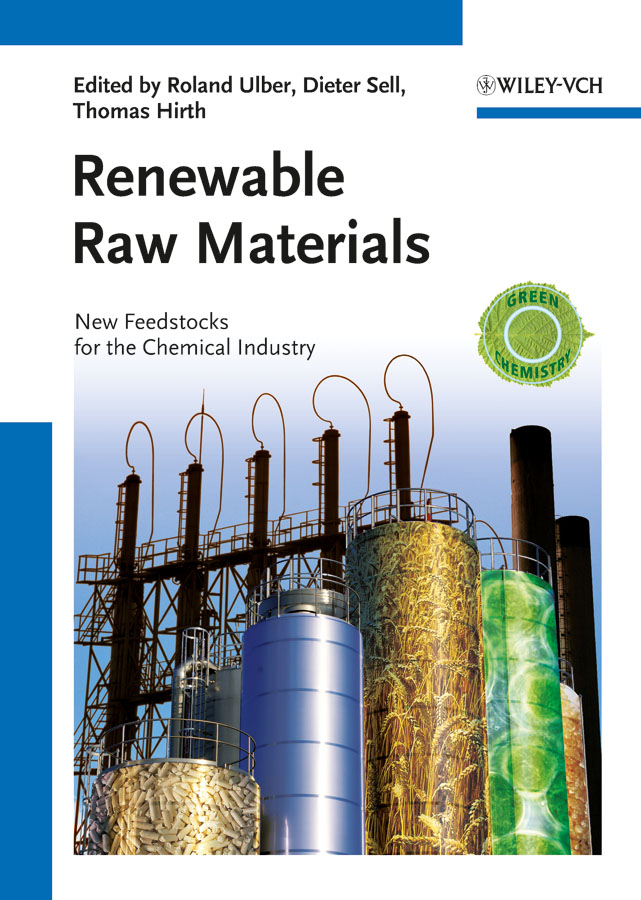
Renewable raw materials: new feedstocks for the chemical industry
Ulber, Roland
Sell, Dieter
Hirth, Thomas
This contemporary overview on a major topic of the 21st century provides an emphasis on cradle-to-grave life cycle assessments of existing or conceptual processes for producing value-added fuels, chemicals, and/or materials from renewable agricultural residues, plant-derived starches and oils (lipids), lignocellulosic biomass, and plant-based industrial processing wastes. It presents the key concepts, systems, and technologies of renewable raw materials, focusingon new feed stocks for the chemical industry. Each chapter is discussed usingcommon themes of specific raw materials, thus forming a natural progression for the entire work. The result is coverage of the topic from a wide array of aspects, emphasizing not only technical aspects but also considering the marketplace and socio-economic aspects. The 'go to' source for those wishing to familiarize themselves with the state of science and technology in the conversionof renewable raw materials -- exploring developments in the use of renewable feed stocks for the production of fuels, chemicals and materials to support a bio-based economy. INDICE: List of Contributors. 1 Introduction to Renewable Resources in theChemical Industry (Roland Ulber, Kai Muffl er, Nils Tippkötter, Thomas Hirth,and Dieter Sell). 2 Plants as Bioreactors: Production and Use of Plant-Derived Secondary Metabolites, Enzymes, and Pharmaceutical Proteins (Peter C. Morris, Peter Welters, and Bernward Garthoff). 2.1 Introduction. 2.2 Renewable Resources in the Chemical Industry. 2.3 Fine Chemicals and Drugs. 2.4 Plant-Made Pharmaceuticals. References. 3 World Agricultural Capacity (John K. Hughes). 3.1Petrochemicals Today. 3.2 Renewable Chemicals. 3.3 Agricultural Production. 3.4 Supplying the Chemical Industry. 3.5 Summary. References. 4 Logistics of Renewable Raw Materials (Magnus Fröhling, Jörg Schweinle, Jörn-Christian Meyer, and Frank Schultmann). 4.1 Introduction. 4.2 Determining Factors for the Logistics of Industrial Utilization Chains for Renewable Raw Materials. 4.3 Processing Steps of Renewable Raw Material Logistic Chains. 4.4 Design and Planning of Renewable Raw Material Logistic Chains. 4.5 Summary and Conclusions. References. 5 Existing Value Chains (Christoph Syldatk, Georg Schaub, Ines Schulze, Dorothea Ernst, and Anke Neumann). 5.1 Industrial Biotechnology Today Main Products, Substrates, and Raw Materials. 5.2 White Biotechnology Future Products from Todays Raw Materials? 5.3 Effects of Feedstock and Process Technology on the Production Cost of Chemicals. 5.4 New Raw Materials for White Biotechnology. 5.5 Case Studies: Lignocellulose as Raw Material and Intermediates. 5.6 CaseStudies: SCOs as Raw Material and Intermediate. 5.7 Conclusions. References. 6 Future Biorefineries (Abbas Kazmi and James Clark). 6.1 Introduction. 6.2 Current and Future Outlook for Biofuels. 6.3 Chemicals from Renewable Resources.6.4 The Role of Clean Technologies in Biorefineries. 6.5 The Size of Future Biorefineries. 6.6 Conclusions. References. 7 Economic and Social Implications of the Industrial Use of Renewable Raw Materials (Antonio Lopolito, Maurizio Prosperi, Roberta Sisto, and Pasquale Pazienza). 7.1 Introduction. 7.2 Biorefinery Industry and the Development of EU Rural Areas. 7.3 From Analytic to Systemic Modeling Methodology of the Biorefinery Industry. 7.4 Stakeholders Perceptions of Biorefinery in Rural Areas: Issues and Lessons from the South of Italy. 7.5 Concluding Remarks. Acknowledgments. References. 8 Biobased Products Market Needs and Opportunities (Rainer Busch). 8.1 Introduction. 8.2 Definition. 8.3 Basic Technology for the Conversion of Renewable Raw Materials. 8.4 Classes of Bioproducts. 8.5 Current Status. 8.6 Outlook and Perspectives. References. 9 Life-Cycle Analysis of Biobased Products (Liselotte Schebek). 9.1 Introduction: Why Life-Cycle Analysis of Biobased Products? 9.2 The Methodological Framework of LCA. 9.3 Specifi c Methodological Aspects for LCA for Biobased Products.
- ISBN: 978-3-527-32548-1
- Editorial: Wiley-VCH
- Encuadernacion: Cartoné
- Páginas: 244
- Fecha Publicación: 09/03/2011
- Nº Volúmenes: 1
- Idioma: Inglés
